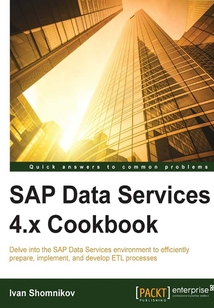目錄(112章)
倒序
- 封面
- 版權頁
- Credits
- About the Author
- About the Reviewers
- www.PacktPub.com
- Support files eBooks discount offers and more
- Preface
- What this book covers
- What you need for this book
- Who this book is for
- Sections
- Conventions
- Reader feedback
- Customer support
- Chapter 1. Introduction to ETL Development
- Introduction
- Preparing a database environment
- Creating a source system database
- Defining and creating staging area structures
- Creating a target data warehouse
- Chapter 2. Configuring the Data Services Environment
- Introduction
- Creating IPS and Data Services repositories
- Installing and configuring Information Platform Services
- Installing and configuring Data Services
- Configuring user access
- Starting and stopping services
- Administering tasks
- Understanding the Designer tool
- Chapter 3. Data Services Basics – Data Types Scripting Language and Functions
- Introduction
- Creating variables and parameters
- Creating a script
- Using string functions
- Using date functions
- Using conversion functions
- Using database functions
- Using aggregate functions
- Using math functions
- Using miscellaneous functions
- Creating custom functions
- Chapter 4. Dataflow – Extract Transform and Load
- Introduction
- Creating a source data object
- Creating a target data object
- Loading data into a flat file
- Loading data from a flat file
- Loading data from table to table – lookups and joins
- Using the Map_Operation transform
- Using the Table_Comparison transform
- Exploring the Auto correct load option
- Splitting the flow of data with the Case transform
- Monitoring and analyzing dataflow execution
- Chapter 5. Workflow – Controlling Execution Order
- Introduction
- Creating a workflow object
- Nesting workflows to control the execution order
- Using conditional and while loop objects to control the execution order
- Using the bypassing feature
- Controlling failures – try-catch objects
- Use case example – populating dimension tables
- Chapter 6. Job – Building the ETL Architecture
- Introduction
- Projects and jobs – organizing ETL
- Using object replication
- Migrating ETL code through the central repository
- Migrating ETL code with export/import
- Debugging job execution
- Monitoring job execution
- Building an external ETL audit and audit reporting
- Using built-in Data Services ETL audit and reporting functionality
- Auto Documentation in Data Services
- Chapter 7. Validating and Cleansing Data
- Introduction
- Creating validation functions
- Using validation functions with the Validation transform
- Reporting data validation results
- Using regular expression support to validate data
- Enabling dataflow audit
- Data Quality transforms – cleansing your data
- Chapter 8. Optimizing ETL Performance
- Introduction
- Optimizing dataflow execution – push-down techniques
- Optimizing dataflow execution – the SQL transform
- Optimizing dataflow execution – the Data_Transfer transform
- Optimizing dataflow readers – lookup methods
- Optimizing dataflow loaders – bulk-loading methods
- Optimizing dataflow execution – performance options
- Chapter 9. Advanced Design Techniques
- Introduction
- Change Data Capture techniques
- Automatic job recovery in Data Services
- Simplifying ETL execution with system configurations
- Transforming data with the Pivot transform
- Chapter 10. Developing Real-time Jobs
- Introduction
- Working with nested structures
- The XML_Map transform
- The Hierarchy_Flattening transform
- Configuring Access Server
- Creating real-time jobs
- Chapter 11. Working with SAP Applications
- Introduction
- Loading data into SAP ERP
- Chapter 12. Introduction to Information Steward
- Introduction
- Exploring Data Insight capabilities
- Performing Metadata Management tasks
- Working with the Metapedia functionality
- Creating a custom cleansing package with Cleansing Package Builder
- Index 更新時間:2021-08-20 10:52:54
推薦閱讀
- MongoDB for Java Developers
- Learning ASP.NET Core 2.0
- Blockly創意趣味編程
- 區塊鏈:以太坊DApp開發實戰
- Python時間序列預測
- Learning OpenStack Networking(Neutron)
- Buildbox 2.x Game Development
- Web App Testing Using Knockout.JS
- 深入理解BootLoader
- INSTANT Apache Hive Essentials How-to
- Developing Java Applications with Spring and Spring Boot
- MongoDB Cookbook
- LiveCode Mobile Development Hotshot
- Oracle API Management 12c Implementation
- Mastering Linux Kernel Development
- 深入理解Android:WebKit卷
- Python for Secret Agents
- OpenCV輕松入門:面向Python
- Java核心技術卷I基礎知識(原書第9版)
- Web前端開發精品課 HTML CSS JavaScript基礎教程
- PHP Reactive Programming
- 數字媒體技術基礎
- Python從入門到精通(微課精編版)
- Refactoring TypeScript
- Mastering QGIS(Second Edition)
- 數據結構(C語言實現)
- Getting Started with ownCloud
- Android Things Projects
- Visual Basic程序設計教程
- 重構與模式(修訂版)


